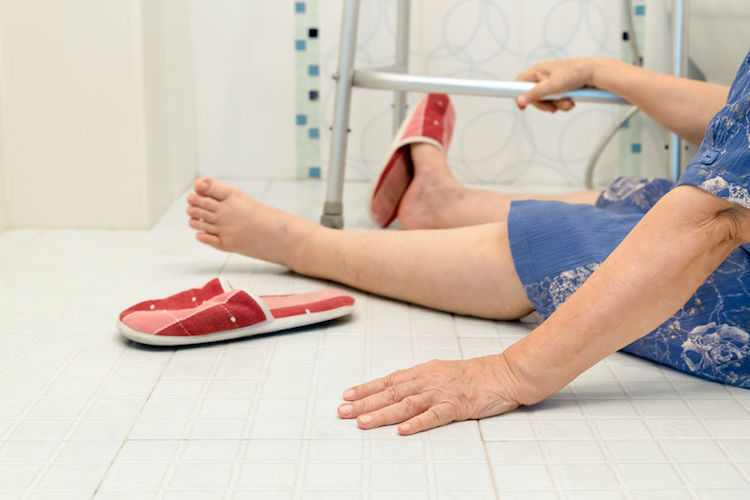Falls are extremely common in the elderly and can happen for a variety of reasons. Sometimes it can be a pure accident such as tripping over a misplaced object or wire and other times it can be the result of poor nutrition, brittle bones or overall lack of strength. Whatever the case may be, seniors are at risk for legitimately being injured any time they fall so it is important to know how these falls happen and what can be done to minimize that chance.
Facts About Falls
Every year, millions of seniors are victims of falls. In fact, according to the CDC, 1 in 3 seniors fall annually, but less than half notify their doctor.
Falling can be severe and very costly. Many traumatic head injuries can be the result of a fall as well as hip fractures and other assorted injuries that require immediate medical attention and care.
After one fall, a person may become very afraid of experiencing another which can result in avoidance behavior and a more sedentary life. This is potentially even more dangerous because it can cause the bones and body to weaken further and increase the risk of falling again; the exact thing that was feared in the first place.
Risk Factors And Causes
Falling does not need to be a part of getting older. In fact, it is entirely preventable once the causes are fully understood and cautioned against. According to the NIH, scientific studies have linked many personal risk factors to falling. A few examples of this are:
- Muscle weakness; particularly in the legs
- Balance and the way you walk
- Postural hypotension or sudden drops in blood pressure
- Slower reflexes and a lesser ability to recover from being off-balance
- Foot problems
- Sensory issues
- Poor vision
- Side effects from medications
Prevention & Safety

There are quite a few ways to prevent falling including making basic lifestyle changes and altering anything in the home or living arrangement that could be potentially dangerous (i.e. wires, clutter, loose carpet, etc.)
Because having weaker legs or bones can often be the culprit of a fall, it is strongly advisable to find an exercise regimen that works for you depending on what you are physically capable of and work towards getting into the best shape you reasonably can. Getting fit can have benefits beyond just preventing the risk of a fall.
Improving the overall safety of your home can also minimize your chances of falling. A few ways to do this would be to add railings and grab bars in places where falling could be more likely to happen such as staircases, toilets, and showers. It is also important to get rid of any clutter or objects on the floor that could cause someone to trip and fall.
Don’t underestimate the importance of eyesight. If you haven’t been to your eye doctor recently, it should be a priority to go and get your eyes checked out. Our eyes and depth perception can play key roles in avoiding falls. Be sure if you have a pair of prescription eyeglasses that they are up to date and have the correct lenses and that you always have them handy when you are on your feet.
Many seniors are on a medication of some sort and in many cases more than one. As we mentioned earlier, these drugs can sometimes cause dizziness and increase the risk of a fall. Talk to your doctor and find out if any of your medications could potentially cause those symptoms.
Some supplements such as Vitamin D or calcium are also thought to be helpful because they can improve and maintain bone health.
What To Do If You Fall

Now that we have gone through some of the facts about falls, the causes, risks, and preventative measures you can take, it is still important to know what you should do if you do fall.
Right after a fall, take a few deep breaths and try to relax. Don’t try to get up right away. Allow the shock of the fall to pass and then decide whether or not you think you are hurt. You could potentially injure yourself worse if you try to rise too quickly or awkwardly.
To get up from a fall, first, roll over to your side. Take another moment to rest and allow your blood pressure and body to adjust and then from your hands and knees, very slowly crawl to the nearest sturdy chair. Place your hands on the seat of the chair and slide one foot forward until you can put it flat on the floor while you keep your support with your other knee on the ground. From this position, slowly rise and turn your body so that you can sit in the chair.
For these situations, it is helpful to have an emergency response system. These work through the press of a help button that activates the system. Once it is activated, a dispatcher will speak through the hands-free system to find out what type of assistance is needed or what has happened. At this point, the dispatcher can either contact anyone that is on the emergency list or the paramedics depending on the severity of the fall or accident.
Regardless of the outcome of a fall, you should make your doctor aware that it has happened even if you were not injured. He or she will be able to assist you in figuring out why the fall occurred and what can be done to help prevent a recurrence.
Falls can be a scary event for a senior to endure especially if you are injured in the process and are alone without any immediate assistance. By educating yourself and applying the precautions discussed in this article, you will be able to minimize the risk of dealing with a dangerous fall of your own and can avoid both injury and the costly medical attention that can follow.
